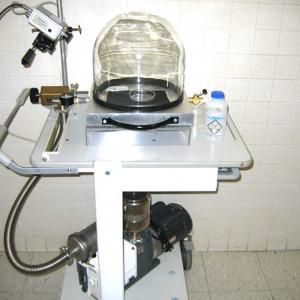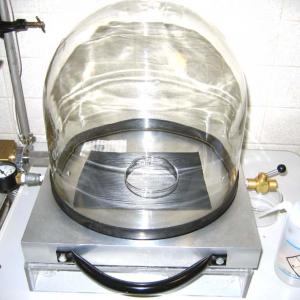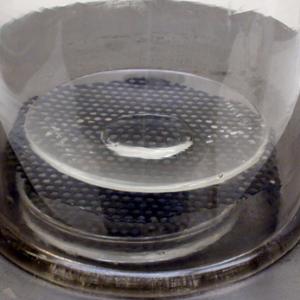College of Liberal Arts & Sciences
4C31.21 - Freezing Water - Reduced Pressure
Video Credit: Jonathan M. Sullivan-Wood.
Warm up the vacuum pump for 30 minutes before performing the demo so that the water will not be absorbed into the pump oil. Place a silver dollar sized spot of water on the watch glass. Open the gas ballast valve on the vacuum pump first, ( this helps keep water from being absorbed into the pump oil ), and then open the valve to the bell jar. The water will appear to boil after 20 seconds and should freeze within 45 seconds.
OLD WAY TO DO THE DEMO: Put the watch glass stand over the dish of sulfuric acid. Put water into the watch glass or Petri dish ( 1 ml or less ). Place the entire apparatus under a bell jar with suitable seals and evacuate. With a motor-driven pump, it will take about 1-2 minutes for the water to freeze.
Note: The sulfuric acid helps greatly when trying to freeze large quantities of water ( 1 ml to 5 ml) and also cuts down on the pumping time. DO NOT let the sulfuric acid stand open to the atmosphere for any length of time as it will absorb water quickly. It will then be useless when performing the demo.
- Paul Hewitt, "Answer to January 2018 Figuring Physics", TPT, Vol. 56, #2, Feb. 2018, p. 117.
- Pietro Ferraro, "Opaque or Opalescent?", TPT, Vol. 37, #1, Jan. 1999, p. 3.
- Mario Capitolo, "Phase-Change Demonstration - Instant Gratification", TPT, Vol. 36, #6, Sept. 1998, p. 349.
- Robert M. Graham, "Freezing by Boiling Using a Low Capacity Pump Without Acid", TPT, Vol. 15, #6, Sept. 1977, p. 367.
- H-280: "Vapor - Liquid - Ice", DICK and RAE Physics Demo Notebook.
- H-70: "Change of State", Richard Manliffe Sutton, Demonstration Experiments in Physics.
- George M. Hopkins, "Cyrophorus", Experimental Science, p. 188.
- Martin Gardner, "Boiling Without Heat", Entertaining Science Experiments with Everyday Objects, p. 107.
- Julien Clinton Sprott, "2.7, Freezing by Evaporation", Physics Demonstrations, ISBN 0-299-21580-6, p. 82.
- Jearl Walker, "4.61, Cool Water from Porous Pottery", The Flying Circus of Physics Ed. 2, p. 203.
- Ron Hipschman, "Water Freezer", Exploratorium Cookbook III, p. 184.1 - 184.4.
- Z. V. Harvalik, "Vacuum by Freezing", Apparatus for Teaching Physics, p. 37.
- Borislaw Bilash II, “Boil It Cold“, A Demo A Day – A Year of Physical Science Demonstrations, p. 70.
- Julius Sumner Miller, Q182 & A182, Millergrams II – Some More Enchanting Questions for Enquiring Minds, p. 48 & 101.
- Joseph Frick, "#10 - Freezing Water", Physical Technics: Or, Practical Instructions for Making Experiments in Physics and the Construction of Physical Apparatus with the Most Limited Means", p. 117.
- "Freezing Apparatus", Pike's Illustrated Catalogue of Scientific & Medical Instruments, 1984, p. 217.
Disclaimer: These demonstrations are provided only for illustrative use by persons affiliated with The University of Iowa and only under the direction of a trained instructor or physicist. The University of Iowa is not responsible for demonstrations performed by those using their own equipment or who choose to use this reference material for their own purpose. The demonstrations included here are within the public domain and can be found in materials contained in libraries, bookstores, and through electronic sources. Performing all or any portion of any of these demonstrations, with or without revisions not depicted here entails inherent risks. These risks include, without limitation, bodily injury (and possibly death), including risks to health that may be temporary or permanent and that may exacerbate a pre-existing medical condition; and property loss or damage. Anyone performing any part of these demonstrations, even with revisions, knowingly and voluntarily assumes all risks associated with them.



